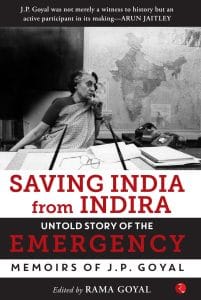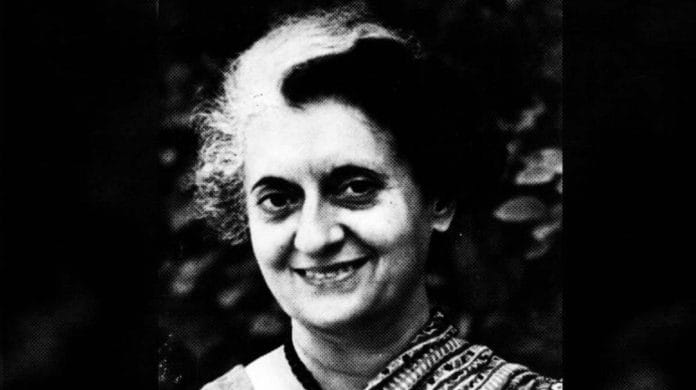The proclamation of the Emergency was made by the President under clause (1) of Article 352 of the Constitution of India around midnight on 25 June 1975. The ‘Interim Report I’ of the Shah Commission of Inquiry provides a detailed account of the events leading up to the Proclamation of Emergency on 25 June 1975, including the stratagem adopted by Smt Indira Gandhi to get the Proclamation signed by President Fakhruddin Ali Ahmed without informing the Cabinet (See Appendix II). Important officials such as the Home Secretary to the Government of India, the Cabinet Secretary, the Director of the Intelligence Bureau, and the Minister of Law and Justice came to know of the Proclamation of Emergency only on 26 June 1975, after it had already been proclaimed on 25 June 1975.
The next day after the Proclamation of Emergency, i.e. 26 June 1975, the Cabinet met at 6 a.m. and approved the Promulgation of Emergency under Article 352 of the Constitution on the ground of the existence of a grave emergency threatening the security of India through internal disturbances. Prime Minister Indira Gandhi informed the Cabinet after the fait accompli of the Proclamation of Emergency and not before. The approval of the Proclamation of Emergency by the Cabinet was thus ex post facto. The Cabinet met at 8.30 p.m. on 26 June 1975 and agreed with the recommendation of the Ministry of Home Affairs to impose press censorship.
Press censorship was imposed by promulgating the Central Censorship Order, dated 26 June 1975, under Rule 48 of the Defence of India Rules, 1971, and Guidelines for the Press in the Emergency period. The Central Censorship Order, 1975 addressed all printers, publishers and editors and prohibited the publication of news, comments, rumours or other reports relating to actions taken by the government without their first being submitted for scrutiny to an authorized officer and the publication being authorized in writing by the officer.
The Prevention of Publication of Objectionable Matters Act, dated 11 February 1976, further defined objectionable matter to include words ‘(a) which are likely to bring into hatred or contempt, or excite disaffection towards the government established by law in India or in any State thereof and thereby cause or tend to cause public disorder’.
On 27 June 1975, on the recommendation of Home Minister K. Brahmananda Reddy, an Order of the President was issued, in exercise of the powers under Article 359 of the Constitution of India, depriving the right of any person (including foreigners) to move the court under Article 14, Article 21 and Article 22 of the Constitution.
On 29 June 1975, the Proclamation of Emergency of 25 June 1975 was made applicable to the state of Jammu and Kashmir by an Order of the President of India, after suitable enabling amendment had been made by an Order of the President of India in clause (4) of Article 352 of the Constitution of India as pertaining to that state on the basis of a recommendation by the Cabinet in its meeting at 8 p.m. on 28 June 1975 and the concurrence of Sheikh Abdullah, the chief minister of the state of Jammu and Kashmir to the application of the Emergency in the state had been obtained.
It was also clarified that restrictions imposed on the legislative and executive powers of the State by Article 19 of the Constitution of India did not operate while a Proclamation of Emergency made under Article 352 was in operation by virtue of Article 358 of the Constitution of India. On 29 June 1975, the Cabinet met at 8.30 p.m. and decided that the Presidential Order of 27 June 1975 issued under Article 359 of the Constitution of India suspending the right to move any court for the enforcement of Articles 14, 21 and 22 be extended to the state of Jammu and Kashmir also.
On 11 July 1975, nearly sixteen days after the Proclamation of Emergency on 25 June 1975, the Intelligence Bureau (IB) submitted to the Ministry of Home Affairs a thirtyfour-page (single-space) report titled ‘The Threat of Grave Internal Disturbance: The Need for the Proclamation of an Emergency’. In this manner, justification for the Proclamation of Emergency was sought to be provided ex post facto, when in fact such a report should have preceded the Proclamation of the President.
A publication titled ‘Why Emergency’ was tabled in the Lok Sabha on 21 July 1975. Resolutions for the approval of the Proclamation of Emergency were moved on 21 July 1975 in the Rajya Sabha and Lok Sabha by Home Minister K. Brahmananda Reddy and Minister of Agriculture and Irrigation Jagjivan Ram, respectively, which were passed by majority votes on 22 July 1975 by the Rajya Sabha and on 23 July 1975 by the Lok Sabha.
 This excerpt from ‘Saving India From Indira: Untold Story of the Emergency (Memoirs of J.P. Goyal)’, edited by Rama Goyal, has been published with permission from Rupa Publications.
This excerpt from ‘Saving India From Indira: Untold Story of the Emergency (Memoirs of J.P. Goyal)’, edited by Rama Goyal, has been published with permission from Rupa Publications.






